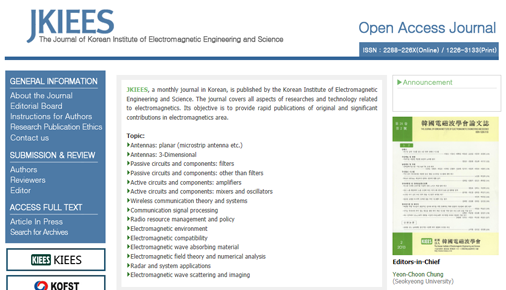주식회사 주니정보통신
- 포트폴리오
- 홈
- > 포트폴리오
- > 서브미션
- Website
- Webzine
- Submission
- Solution
- Mobile
전자파학회(국문저널)

- Client
- 전자파학회(국문저널)
- URL
- jkiees.org
- Overview
▶ About the Journal
JKIEES (The Journal of Korean Institute of Electromagnetic Engineering and Science) was launched in 1996 and has been published Monthly by the Korean Institute of Electromagnetic Engineering and Science. It was selected as a candidate journal to be registered with National Research Foundation of Korea and finally registered with the Foundation in 2004. For a period of 16 years, about 2,300 excellent papers have been published by our journal. JKIEES has posted papers largely on profound research of antennas, microwave engineering, EMI/EMC, and applied electromagnetics. Its fields of contributed paper also have been expanded into diverse areas such as wireless communication systems, spectrum engineering, RF systems, electromagnetic materials, radar and radio application, and electromagnetic scattering and imaging.
Since 2004, JKIEES has encouraged contributions from authors whose papers were recommended as excellent papers by academic conference heads and posted their papers in featured sessions Since 2004, JKIEES has encouraged contributions from authors whose papers were recommended as excellent papers by academic conference heads and posted their papers in featured sessions.
▶ Aims and ScopeJKIEES is an official journal of the Korean Institute of Electromagnetic and Science. The objective of JKIEES is to publish academic and industrial research results on electromagnetic engineering and science. In particular, EMI/EMC, microwave and millimeter-wave engineering, antennas and propagation, electromagnetic theory, wireless communication, lightwave and electro-optics, materials and components, SDR, radar, and bioelectromagnetics are in the scope of the Journal. With the Journal researches on electromagnetic wave-related engineering and science will be nourished and ultimately contributed to improve the welfare of the human race and national development.
▶ ISSN number and DOI prefixISSN : 1226-3133 (Print) / 2288-226X (Online)
DOI Prefix : http://dx.doi.org/10.5515/KJKIEES
▶ Financial SupportThis journal was supported by the Korean Federation of Science and Technology Societies Grant funded by the Korean Government (MEST).
